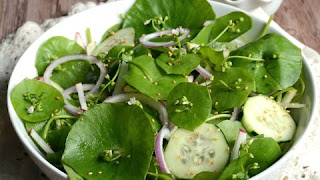MINER'S LETTUCE - Montia Perfoliata, Claytonia Perfoliata,
Montia
Cordifolia.
Also known as:
Indian lettuce, Winter purslane, Spring Beauty.
Parts used:
whole plant.
Systems/Organs affected: heart, lymph, blood, liver.
Properties:
tonic, nutritive, anti-rheumatic, anti-scorbutic, diuretic, mucilaginous,
anti-inflammatory.
Miner's Lettuce is a lovely little plant often looked on as a weed (as
it can be invasive). Nothing could be
further from the truth. It was once
classified as part of the purslane family (Claytonia), but has since been put
into its own class (Monticeae). There
are roughly 230 species of Miner's Lettuce. This plant is considered an annual (even though
it seems to come back every year) that can get up to a foot tall. The leaf stalks can get from 3-12 inches long
and the leaves kind of have this cup and saucer shape. The flowers grow up through the bottom center
of the leaf on a stalk of its own. The
flowers are usually pink or white, have five petals, and are very tiny. Miner's Lettuce is native to
the western coastal and mountain regions,
It grows from British Columbia to California and east into Idaho and
Montana. It can be found in lots of states
now, though, especially in forest areas where the soils are dry and/or moist
and shaded. It was also introduced to
Western Europe about the 18th century, and it has flourished on that continent
as well. Miner's Lettuce
is an early green, generally appearing between March and June.
Miner's Lettuce is a plant that cannot be mistaken for something else
given its unique look. It actually got
its name from miners back in the 1800s as they consumed the plant to keep from
getting scurvy. It also was used in tea
form as a cleansing agent to filter the blood and lymph systems; it was later
found that the tea could cleanse the liver as well. The Native Americans refer to it is Indian
Lettuce and, aside from eating it, used it as a spring tonic, a laxative, a diuretic,
and mashed it up to use as a poultice for rheumatic joints, minor burns, and
skin irritations. The Songish Indians
used it for headaches. The roots were
also boiled, peeled, and eaten (they were said to taste like chestnuts).
Miner's Lettuce also has quite a bit of nutritive value. Just a small handful of this herb provides
around 500mg Vitamin C, about 10% of your daily requirements of iron, and 22%
of your daily requirements for Vitamin A.
Also called 'winter purslane' (no doubt due to its early arrival in the
year), it contains a fair amount of Omega 3s (ALAs as well) which makes the
plant a decent option for cardiovascular function.
Miner's Lettuce has a knack of being able to thrive in places where
other plants may not; it is said that a farmer once saw Miner's Lettuce thriving in his fields while his area was
experiencing the worst drought in history.
The farmer stated, "Whatever is in that plant that keeps it
alive and healthy, I want that in my blood." Miner's Lettuce is rich in chlorophyll,
which provides quick energy for the lymph and liver (not to mention hastening
the detoxification process).
While Miner's Lettuce is considered a mild
plant, please consult a qualified physician before starting any herb or
herbal regimen.
As is customary with my posts I am including some links for your perusal. Enjoy! Stay strong and healthy!
https://www.amazon.com/Outsidepride-Winter-Purslane-5000-Seeds/dp/B006U1R9CK/ref=sr_1_2?ie=UTF8&qid=1533671562&sr=8-2&keywords=miners+lettuce
https://www.amazon.com/Miners-Lettuce-Seeds-Claytonia-Perfoliata-Cold-hardy/dp/B01CUNH408/ref=sr_1_15?ie=UTF8&qid=1533671562&sr=8-15&keywords=miners+lettuce






No comments:
Post a Comment